Conflicts and positive affect
Conflicts are an inevitable aspect of life. We are constantly being bombarded by updates of conflicts happening around the world. Fact is, the conflict filled world that we live in is still the most peaceful era that the world has seen in history. So if you are feeling depressed by all the conflicts around you, just know that you are here in the best possible time!
This article lowers the scope of conflicts down to the type of conflicts that happen in the everyday work place. We are ignoring international conflict and civil conflicts that you here a lot about and narrowing down the topic to the conflicts that happens to most of you, the conflict that you are subjected to the most.
What is conflict?
Conflict, in the simplest term is a disagreement between individuals or groups of people. This general definition is applicable to any type of conflict you can think of, no matter how great and wide the scope is. In intra-organizational conflict, these happen to prevent people from reaching a consensus about a decision.
Conflicting views about...conflict
There are two views of conflict when applied to the business world. The traditionalist view states that conflicts are always detrimental to organization process. It deters the business as usual mantra that corporations like to have. The traditionalist view is supported when you really think about the definition presented before.Conflicts slows down decision making. More time is spent on trivial matters. Times equals money and... you know where this ends.
The interactionist view of conflict states that conflicts, being an inevitable aspect of life and business in general, is not always detrimental to the business and is sometimes, even beneficial. This view also states that conflicts are an aspect to be managed, not always avoided as is stated in the traditionalist view.
The following discussions are mainly based on the interactionist view, because in the author's opinion, the traditionalist view is more aligned with glass-half-empty view.
Types of conflict
Following down the path set by the interactionist view, this article explores differentiating conflicts.
Based on outcome
Conflicts can be either rewarding or damaging. Conflicts that lead to rewards or benefits are known as functional conflicts. Functional conflicts are conflicts that get sorted out in the end and the disagreement gets resolved. Due to it being resolved, these disagreements are seen to open doors and paths that were previously closed to the participants, an exchange of knowledge takes place between them and every one, including the business, is rewarded by the outcome.
If that explanation sounds unrealistic and too optimistic, think about some ways decision are made in your organisation. If your organisation involves staff in brainstorming, group thinking and other such methods for decision making, then you already been involved in functional conflicts. These are just labels for ways conflicts are managed in a functional manner.
On the other end of the conflict spectrum sits dysfunctional conflict. These are the opposite of functional conflicts. There is no reward here, the disagreement may or may not be resolved, and the business always suffers.
The interactionist view of conflicts, along with the discussion presented about functional and dysfunctional conflicts, can be summarized as below. There is a certain point (Point A) where conflicts lower than that causes the unit performance to be lower. In a similar fashion Point C represents the level of conflict above which the unit performance is again lower. Point B represents the optimum level of conflict, where functional conflicts results in the unit performance to be increased.
Figure 1: Interactionist view of conflicts
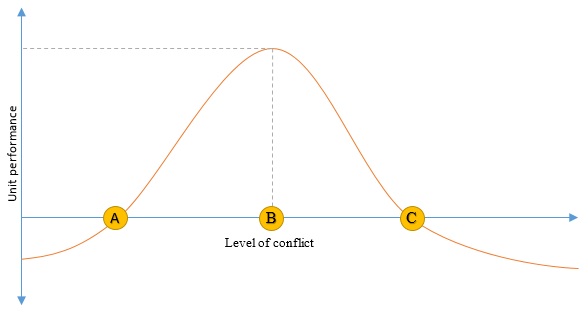
Based on source
Conflicts can be classified based on where it stems from. In the work environment, this is one of the following
Task conflicts are conflicts resulting from goals that you set and the content of the work. Relationship conflicts are interpersonal conflicts with coworkers and peers. Process conflicts are about the way work is done. Out of these types, relationship conflicts are the one to look out for as they are always dysfunctional.
Conflict process
Figure 2: The 5 stage conflict process

The conflict process shown in Figure 2, compliments the explanation for Figure 1, where certain conflicts produces increased and decreased performance. Before moving on to explain behavior by discussing emotions and moods in the next sections, let's talk about Stage 3: Intentions.
Stage 3 represents intentions, which are decisions to act in a given way. These are also negotiation handling tactics, so some of these terms might be familiar to those of you who dwell in that knowledge area. These five tactics is explained shortly.
- Competing: Not giving a second thought to the other parties interests and arguments in a conflict. The only interest you have is winning at all costs
- Collaborating: Work with others by trying to fulfill the needs of all parties involved with the conflict.
- Avoiding: Withdrawing, suppressing and not acknowledging that a conflict exists
- Accommodating: Interests of other parties are more important, and fulfilling them is the primary objective
- Compromising: A no winner and loser scenario. All parties may be ready to accept a solution that they are not completely happy about.
Figure 3 presents these tactics along the two dimensions of cooperativeness and assertiveness. Cooperativeness is the degree to which the party attempts to others concern and assertiveness is the degree to which the party attempts to satisfy their own concerns.
Figure 3: Conflict resolving intentions
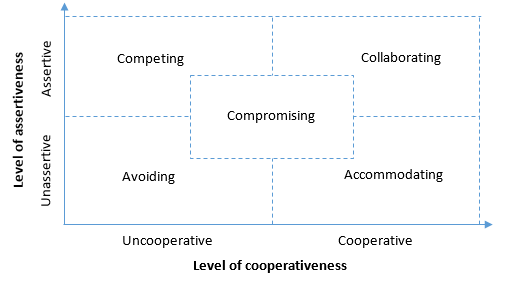
Given all this where does Liam Neeson's character fall?
Positive affect
We discussed about how conflicts can lead to benefits, an increased in unit output and support objectives of the organization, without really dwelling into why it happens.
Affect (not to be confused with effect), in this context, is the range of feelings that people could experience. Even though the terminology is usually interchangeably, affect is a term that encompasses moods and emotions. Emotions are intense feeling directed at something and someone. Moods are less intense, and arises without any specific event to related to it. They are also not directed towards someone or something.
Figure 4: Basic moods and emotions
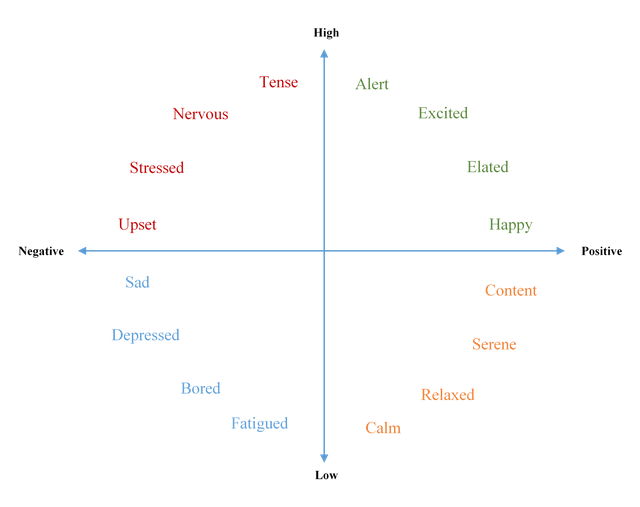
The positive affect (represented by the right half of Figure 4) is what you should sought out in conflicts, to make them functional. It wasn't too long ago, that emotions and moods were thought to be detrimental to work place, whether it's positive or negative. But using the Affective Events Theory (AET) shown in Figure 5, it is possible to show that emotions and moods, similar to conflicts, should be managed. AET is the sub process of Stage 4 of the conflict process.
Figure5: Affective events theory
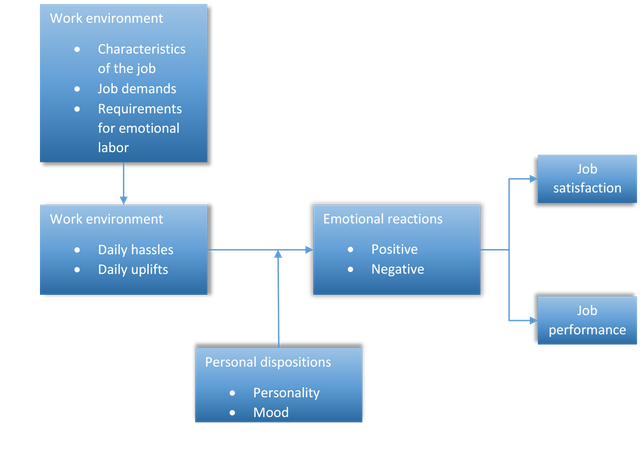
Conclusion
The interactionist view of conflicts states that conflicts are not always bad... in the organizational scope. How about other conflicts in the world? Are the conflicts in the bigger scope, international and civil conflicts at some point beneficial to the parties involved? For organizations AET explains how it is beneficial, but in the bigger picture, what processes govern the conflict? AET is good at explaining positive and negative affect for a small group of people and individuals, but is redundant for larger groups, such as nations and political parties. These scenarios needs to be managed in a different scope of the knowledge area known as conflict management.
Note: Post is an article I wrote for the website Rules of Knowledge
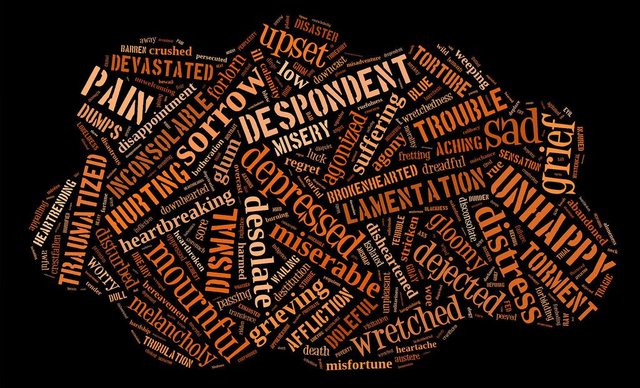
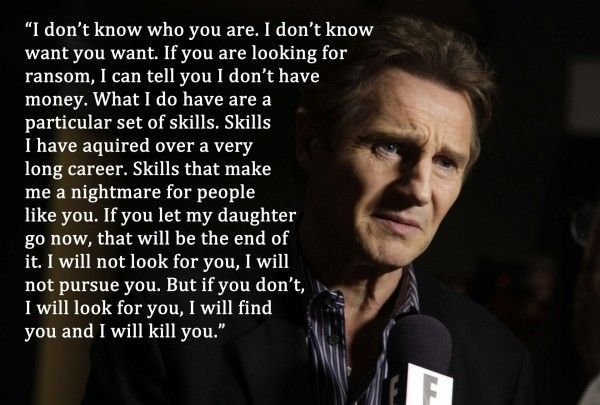
Hi! I am a robot. I just upvoted you! I found similar content that readers might be interested in:
https://rulesofknowledge.com/2016/10/19/conflicts-and-positive-affect/
Good article.
By assuming that your are the original author, I upvoted. However, it's best if you can prove that you're the author, simply by writing something about Steemit (for example
I'm now posting with @stormofmort handle on Steemit.com) on https://rulesofknowledge.com/author/stormofmort/ , or on your blog https://stormofmort.wordpress.com/ . You can also make a #introduceyourself post so others will know more about you, I believe you'll be welcomed.Good luck!
I have followed your recommendations by posting on both Rules of Knowledge and my blog. I've also posted an introductory post.
Thank you for the recommendations and the upvote